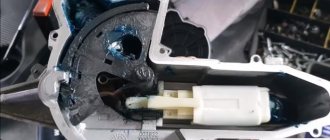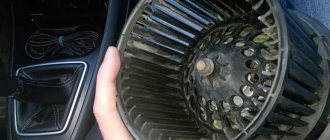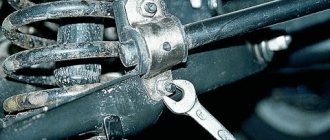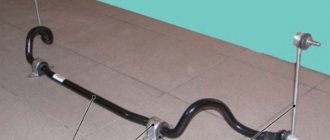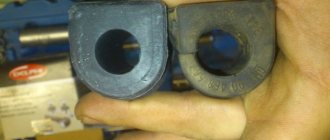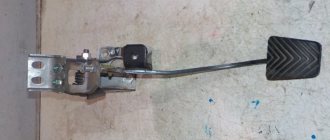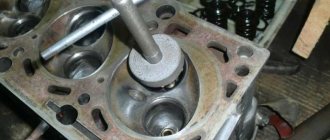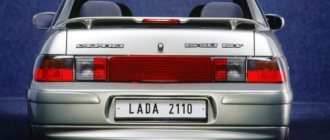Stabilizers are responsible for the vehicle's stability on the road. To eliminate noise and vibration from the operation of the components of the stabilizers, special bushings are used - elastic elements that give smooth operation.
What is a bushing? An elastic part is created by casting from rubber or polyurethane. Its shape remains virtually unchanged for different car models, but sometimes has some features depending on the design of the stabilizer. To improve the performance of bushings, they sometimes have bosses and grooves. They strengthen the structure and allow parts to last longer, and also protect against mechanical stress that can damage them.
Firmness or comfort
All this, of course, speaks not only about the inoperability of the silent blocks, but about a change in the suspension geometry, but this can be checked simply. Upon visual inspection of the part, there should be no breaks, swelling or cracks on its surface. Regardless of the brand of silent blocks, polyurethane can bring a different sensation to each driver. Some will find it harder to drive, others will note increased sharpness in handling and stability when cornering, but for others this does not matter at all, the main thing is the soft suspension and comfort.
Subaru Impreza 2008, 110 l. With. - with your own hands
Cars for sale
Subaru Impreza, 2008
Subaru Impreza, 2008
Subaru Impreza, 2008
Subaru Impreza, 2007
When should I replace the front stabilizer bar bushings?
By carrying out a visual inspection of the stabilizer bushings from time to time, you can identify their wear. If there are cracks on the bushing, or the shape has changed (there are large abrasions), then the stabilizer bushings must be replaced.
The service life of stabilizer bushings for most brands and models of cars is 30 thousand km. If only one bushing is worn out, it is recommended to replace the complete set in order to increase the time between overhauls for replacing bushings.
If dirt is visible during visual inspection, it is better to clean them, thereby protecting them from accelerated wear.
Signs when it is necessary to change the stabilizer bushings in a car:
- if there is wheel play when turning;
- if the steering wheel shakes;
- if there are squeaks when the car tilts (roll);
- if the suspension vibrates (there is extraneous noise);
- if when driving straight the car pulls to the left or right;
- and, if at all, there is instability while driving.
These signs, first of all, indicate wear of the stabilizer bushings. The same signs may also be accompanied by wear of silent blocks. Such problems are eliminated by replacing the silent blocks of the front levers and subsequent work on wheel alignment. Therefore, you should check them and carry out repair work with your own or someone else’s hands to replace the stabilizer bushings. Play can also appear if the wheel is severely imbalanced. It disrupts the balancing when hitting a hole, or, for example, when pumping sealant into a tubeless wheel to close a puncture.
Stabilizer bushings creaking
Often, owners of passenger cars complain about creaking stabilizer bushings. It often occurs during frost or dry weather. However, the conditions of occurrence manifest themselves individually.
Causes of squeaks
The main reasons for this problem are:
- low quality of the material from which the stabilizer bushings are made;
- rubber hardening in the cold, causing it to become inelastic and squeak;
- significant wear of the bushing or its failure;
- design features of the car (for example, Lada Vesta).
Methods for solving the problem
Some car owners try to lubricate the bushings with various lubricants (including silicone grease). However, as practice shows, this gives only a temporary effect (and in some cases it does not help at all). Any lubricant attracts dirt and debris, thus forming an abrasive. And this leads to a decrease in the life of the bushing and the stabilizer itself. Therefore, we do not recommend that you use any lubricants .
In addition, it is not recommended to lubricate the bushings due to the fact that this violates the principle of their operation. After all, they are designed to tightly hold the stabilizer. Being essentially a torsion bar, it works in torsion, creating resistance to the car's roll when cornering. Therefore, it must be securely fastened in the sleeve. And if there is lubrication, this becomes impossible, since it can still turn, making a creaking noise again.
The recommendation of most automakers regarding this defect is to replace the bushings . So, general advice for car owners who are faced with the problem of squeaking from the stabilizer is to drive with the squeaking for a certain time (one or two weeks is enough). If the bushings do not “grind in” (especially for new bushings), they will need to be replaced.
In some cases, replacing rubber bushings with polyurethane ones . However, this depends on the machine and the bushing manufacturer. Therefore, responsibility for the decision to install polyurethane bushings lies solely with car owners.
Stabilizer bushings must be replaced every 20-30 thousand kilometers. Look for the specific value in the manual for your car.
To solve the problem, some car owners wrap the part of the stabilizer that is inserted into the bushing with electrical tape, thin rubber (for example, a piece of a bicycle tube) or cloth. Original bushings (for example, Mitsubishi) have a fabric insert inside. This solution will allow the stabilizer to be seated more tightly in the bushing and will relieve the car owner from unpleasant sounds.
Signs and causes of malfunction
The most common cause is normal wear and tear. The service life of a part installed from the factory is approximately 50 thousand km, but the quality of domestic roads can reduce this period by half.
The service life of the parts installed during replacement depends on the raw materials from which they are made. For example, plastic used to produce cheap spare parts degrades noticeably faster than material for high-quality analogues or original products.
Anti-roll bar: design and purpose
The anti-roll bar is an indispensable suspension part. It ensures reduced body roll when cornering, increased wheel grip on the road surface and even distribution of load on the frame. Its shape resembles a metal beam with curved ends. It is attached on each side to the wheels of one of the axles, most often in the front (front stabilizer). This structural element is also attached to the car body. The central beam with stabilizer bars is a torsion bar that connects both wheels to the base of the car.
How to identify signs of wear on stabilizer bushings?
The occurrence of the following malfunctions during vehicle operation will indicate a malfunction of the stabilizer bushings:
The first warning sign when the bushing fails will be the appearance of noise and knocking in the suspension when the car is moving. The difference from malfunctions with shock absorbers will be that the suspension will knock not only when passing uneven surfaces, but also when entering turns with a small radius
Moreover, the road surface in this case may be in good condition and not contain any unevenness; If you do not pay attention to the knocking sound in the suspension and continue to drive the car, the situation will begin to worsen. Suspension noise will increase and will be caused by any change in suspension position
This will happen due to an increase in cracks and deformation of the stabilizer bushings; the next step will be the appearance of a large roll of the car when making turns with a small radius. The body will sway violently; In some cars, play in the steering wheel may occur. This is due to their design features; Further ignoring the situation will lead to the car's controllability deteriorating. The car may start to move from side to side when trying to make any maneuver.
You should not bring your car to this state, because this endangers not only your life, but also the safety of other road users.
Important! Most stabilizer bushings have a service life of 30 to 40 thousand kilometers. Do not exceed this figure and risk your safety
If you do not have the opportunity to take the car to a service center for diagnostics, you can verify that the bushings are faulty on your own. To do this you need:
- find an overpass or pit for inspection. In this case, you should not use jacks or lifts. The fact is that the test will be accompanied by strong rocking of the car and strong physical impact on the stabilizer. Because of this, the car may lose stability and jump off these devices. At best, this can result in injury, at worst, death. Therefore, to ensure maximum safety, it is recommended to use overpasses and pits;
- Next, a visual assessment of the condition of the rubber bands is carried out. If any cracks or breaks are detected, such a part must be replaced;
- Next, you need to make a strong physical impact on the stabilizer. Tug it in different directions. Creaks and noise accompanying this action will indicate the need to replace the bushing.
Independent work
In this case, there are several ways:
- Bushing lubrication;
- Replacement with analogues.
Bushing lubrication
If you choose this option, everything is done exactly the same as when contacting a dealership. However, car owners choose the lubricant themselves. Some people buy regular mastic, others use foreign lubricants, for example, Japanese ones.
Owners buy different lubricants
Be that as it may, these are only temporary measures, since mastic and other lubricants are still quickly washed out. It may last a little longer, but that doesn't solve the problem.
Replacement with analogues
According to reviews from owners, most often either bushings from Chevrolet Niva or components from KIA are used.
Bushings from Chevrolet Niva
Elements from this model are suitable for Lada Vesta, which can be bought at almost any car store. In addition, they can be ordered online using the following article numbers:
— 2123-2906046;
— 2123-2906040.
Stabilizer bushings from Chevrolet Niva
The second type of product has larger dimensions, so it is used more often. The price of bushings from Chevrolet Niva is about 150 rubles per pair. However, there are also polyurethane products on sale, which are often painted in bright colors (yellow, red, etc.). The price of polyurethane products reaches 250 rubles per piece.
You can purchase products from one of the resources below:
- https://www.autopiter.ru/goods/21232906046/rossiya/id51385878
- https://niva-lada4x4.ru/product_info.php?products_id=4152
- https://tankomobile.ru/polyurethan-chevy-niva.html
- https://www.nivashop.ru/catalog.html?idc=420&stype=4
However, Vest owners note that elements from the ChevyNiva also often creak, and it doesn’t make much difference what material they are made of - rubber or polyurethane.
Bushings from KIA
These are more expensive components, which can be purchased under article number KSBSOULF or 54813-2K100. The price for such products is significantly higher than for similar ones from ChevyNiva. Usually the cost varies between 400-650 rubles, but the price can reach 850 rubles per piece. Therefore, it is recommended to monitor offers from various suppliers before purchasing. In this case, you need to buy only original products. Purchasing a non-original one is fraught with the same creaking noise, which is extremely unpleasant, because bushings from a Korean manufacturer are not cheap.
Products from Kia
You can purchase them on one of the following sites:
- https://koreanaparts.ru/product/548132K100/730
- https://www.autodoc.ru/part/hyundai-kia—647/548132k100/
- https://www.autopiter.ru/goods/548132k100/hyundai-kia/id11105217
- https://plentycar.ru/autopart/1981834
In addition, it is worth taking into account the configuration of parts from HYUNDAI-KIA, which differs significantly from that of the Lada Vesta. For this reason, along with the bushings, you need to buy brackets for them, which are sold under article number 54814-1G000. The price tag for them ranges from 300 to 500 rubles per piece.
Comparison of Russian and Korean elements
You can order brackets online at the following addresses:
- https://koreanaparts.ru/product/548141G000/730
- https://nomer52.ru/kronshtejn-vtulki-stabilizatora_hyundai_elantra-hd_548141g000_mobis_i126/
- https://www.autodoc.ru/part/hyundai-kia—647/548141g000/
- https://www.autopiter.ru/goods/548141g000/hyundai-kia/id11105233
Bracket for bushings from Kia
Replacing front stabilizer bushings
Regardless of the car model, the general procedure for replacing bushings remains the same. Only the instruments and some details of the procedure change. Even a novice driver can guess what exactly needs to be done as an additional action.
Front stabilizer bushing
To do this you must follow the following points:
- Place the car stationary on a pit or lift.
- Using tools, loosen the bolts of the front wheels.
- Remove the car wheels completely.
- Unscrew the nuts securing the struts to the stabilizer.
- Separate the struts and stabilizer.
- Loosen the rear bolts securing the bracket framing the bushing and unscrew the front ones.
- Using available tools, remove dirt from the area where the new bushings will be installed.
- Using silicone spray or soap solution, thoroughly lubricate the inside of the bushings.
- Install the bushings and perform a series of procedures inverse to those listed to return the car to working condition.
To install new bushings on some car models, it may be necessary to remove the crankcase protection. This will make the replacement process easier.
Replacement of the rear stabilizer bushings is carried out in the same way. The only thing is that removing the front bushings is sometimes more difficult due to the complexity of the car's front design. If the driver manages to change the front bushings, then he can probably cope with replacing the rear bushings.
Often the reason for replacing bushings is that they squeak. This factor, although not critical, still causes inconvenience to many drivers and passengers.
Contacting the dealer and AvtoVAZ’s position
If you have decided to contact a Lada dealership, you will most likely be unpleasantly surprised. The fact is that the Russian automaker, although it recognized the problem, took the simplest path to solving the issue.
At the dealership, the bushings are lubricated with grease.
The craftsmen do not replace the bushings, but simply lubricate them with PMS 400 grease. To carry out lubrication work, the unit is disassembled and then reassembled. PMS 400 is an emulsion-based lubricant with adhesive properties. It is widely used in defoamers and in plastic-to-metal contact areas. It has hydraulic, shock-absorbing, cooling and damping properties.
The result of using this lubricant is twofold. The Vesta stabilizer bushings actually stop squeaking, but this does not last long. The reason is that the lubricant is quickly washed out (literally within 100-150 km) and the sounds are heard again. This moment is especially pronounced in the fall, during rainy weather.
➤ The stabilizer bushings creak (crunch). What to do?
A creaking sound in the front suspension is the first sign of a design defect. This is typical for both a new car and one with a mileage of 100,000 km.
- The rubber bushings on the suspension elements are worn out and deformed. Metal surfaces begin to rub against each other.
- Poor quality gasket material.
- Failure to comply with the proportions of components during manufacturing increases the rigidity of the material. An unpleasant sound is produced upon contact with a metal surface.
avtoexperts.ru
The quality of road surfaces in many places in Russia leaves much to be desired. In this regard, the suspension should be treated practically as a “consumable”. A prompt response to extraneous noise in the suspension will allow you to avoid expensive repairs, accidents, and deterioration in driving characteristics by promptly identifying the cause of the malfunction. The appearance of a squeak in the suspension in most cases foreshadows a quick repair.
Car suspension
When might a creaking sound appear in the suspension?
A serviceable and correctly configured chassis does not produce any extraneous sounds. At risk are mainly cars with mileage of 100-150 thousand kilometers. Depending on the make and model, unpleasant sounds may occur earlier. Creaking can occur in any conditions - when turning the steering wheel, driving on an uneven surface, passing speed bumps, driving at a certain speed, etc.
What can cause a squeak to appear:
• The quality of the road surface on which the vehicle is operated;
• Driver's driving style;
• Penetration of sand, dirt, and water into moving joints, which reduces the service life of elements;
• Mileage and age of the car;
• Quality of parts (if suspension elements have already been replaced).
According to statistics, squeaks most often occur in the front suspension. This part of the car contains a large number of components and connections - steering rack, rods, ends, etc. The power unit and other necessary components and assemblies are located at the front, which increases the load on the front suspension. Because of this, its resource is often less than that of the rear part.
Front suspension
Silent blocks and stabilizer bushings
Contenders for the source of squeak No. 1. Rubber elements are combined with metal ones, and when they move together, friction occurs. This causes an unpleasant and annoying sound.
On the left are stabilizer bushings, on the right are silent blocks
The main reasons for the creaking of silent blocks:
• Wear. Cracks, play and other mechanical damage indicate the need to replace the element. The exhausted “elastic band” ceases to absorb the load. This role is transferred to the lever, as a result of which controllability suffers and the load on other elements of the chassis increases.
Faulty silent block
• Incorrect installation. Tightening the silent block on a suspended car can lead to unpleasant sounds. In some cases, lubrication with special long-lasting lubricants helps.
• Design feature. The suspension of some budget models may squeak in rainy or cold weather. And sometimes just like that. A striking example is the Lada Vesta, whose rear stabilizer bushings squeak from the factory. Lubrication or replacement with analogues with softer rubber helps.
Stabilizer bushings Lada Vesta
The design of some vehicles does not allow for individual replacement of silent blocks on some or all levers. In this case, you will have to spend money on a new lever.
The creaking of the bushings appears from natural wear, when the space between the rubber and the metal part increases, play appears. Untimely replacement threatens to wear out the stabilizer. In some cases, this is a design feature that can be resolved by lubrication or replacement with a softer rubber band.
Stabilizer bushings
The presence of polyurethane silent blocks in the design, especially where they are not provided, can cause creaking due to the rigidity of the rubber. Try to avoid purchasing silent blocks and bushings with low-quality rubber. Even with abundant lubrication, the possibility of squeaking is present.
Ball joints
The appearance of a nasty squeak when turning the steering wheel or while moving indicates wear on the ball joint. The service life of this unit ranges from 30 to 150 thousand, depending on the road surface, driving style and quality of the part. It is recommended to replace it as quickly as possible, since there is a high probability of “losing” the wheel at speed or when turning the steering wheel sharply. At best, the arch will suffer, at worst, the flight path of the tire can be anything.
Ball joints Ford Focus II
To extend the life of the ball joint, it is recommended to monitor the rubber protective casing - boot. It prevents dirt, dust and other debris from entering the element. If you neglect the boot, the service life of the ball joint will be significantly reduced.
Outer CV Joints
Checking the wear of the outer “grenade” is not difficult. It is enough to turn the steering wheel in one direction and then the other. If there is a malfunction, such manipulations will be accompanied by creaking and crunching.
Hyundai Accent CV joint boot torn
The main cause of wear is torn anthers, which allows dust, water and dirt to enter the structure. Under such conditions, a part can fail in a matter of days. As a rule, it is recommended to change them in pairs.
New CV joint
Shock absorbers and springs
Poor road surface, careless driving over bumps, potholes, and speed bumps lead to the breakdown of these suspension elements.
• A faulty shock absorber can be identified visually – by oil leaks. Due to the friction of the rod against the sealing element, an unpleasant creak occurs. Another reason is the lack of vibration damping. Just try to manually rock the car and see how quickly the body stops rocking. If there is strong swaying, there is only one verdict - replace it.
Shock absorber
• Springs. Squeaking noises when driving on poor surfaces or driving over speed bumps and other irregularities can be caused by worn springs. Due to wear and aging of the metal, one turn breaks, which leads to unpleasant sounds. Do not delay replacement, as a sharp edge can destroy the plastic or rubber spring support.
Broken spring in Skoda Octavia A7 suspension
Steering rods and ends
Worn steering rods can be identified by a distinct squeaking noise when the steering wheel is turned in place. Failure occurs due to torn anthers. Dirt and debris gets inside, which leads to rapid breakdown. It is recommended to change tie rod ends in pairs. If during diagnostics of the suspension you notice a torn boot, it should be replaced and the tip checked for functionality.
Top - tie rod, bottom - tip
Bearings
When the steering wheel is rotated, a squeaking noise may be heard from the steering knuckle area. The appearance of an unpleasant sound is due to debris getting inside or a small amount of lubricant. This can be solved by high-quality cleaning followed by abundant lubrication. Or replacing it with an original or a high-quality analogue.
Bearings in the steering knuckle of Nissan Primera
Steering column and rack
Creaking when turning the steering wheel and maneuvering can occur due to a faulty steering rack or column. There are a lot of reasons - damaged boots (dirt and debris got in), wear of the main elements, leaking seals and much more. The steering mechanism is a complex thing, especially in modern cars. Therefore, it is simply not possible to carry out independent diagnostics due to the lack of technical capabilities.
Places that needed to be lubricated. 1994 Toyota Corona steering column
What to do if a squeak is detected?
You should stop by for diagnostics so that the technician can begin searching for the source of the unpleasant squeaking noise. In some cases, finding an annoying sound can become a whole quest. A good solution would be to use a vibration stand. It allows you to create the load that the car experiences when driving on the road. Thus, you can clearly listen to all foreign sounds in the chassis.
Vibration test
Do not forget that in addition to suspension elements, other components can also produce creaking:
• Brake pads. They make an extremely unpleasant sound when braking. There are many reasons - dirt, wear, improper installation, poor quality materials.
Brake pad with anti-squeak lubricant applied
• Muffler mounting. The can is secured using rubber elements, which can wear out over time. The resulting play can produce creaking sounds.
Exhaust connections
To find the cause, you should carefully check the rubber elements of the chassis for integrity.
What to do: the suspension elements are in working order, but there is a squeak?
If during the diagnostics no breakdowns of the above elements were identified, then you should look for the source of the noise in another place. For example, tires rubbing against the wheel arch and hitting the fender liners can make an unpleasant sound. A similar situation arises due to exceeding the dimensions established by the manufacturer. Negatively affects the wear of tires and arches.
Another reason could be excess pressure inside the wheel. As a result, a creaking noise may be heard when turning. In addition, the tires themselves can squeak. Budget Velcro models produce unpleasant sounds. And some manufacturers coat new rubber with a thin layer of oil, which can also create a squeak. But, as a rule, after 100-200 km it disappears.
